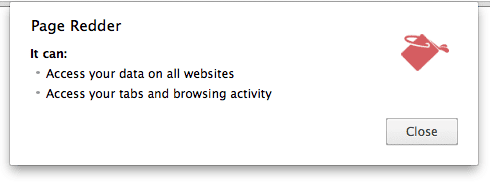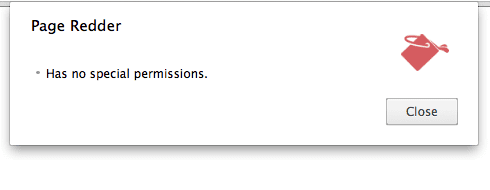The "activeTab" permission gives an extension temporary access to the currently active tab when the
user invokes the extension - for example by clicking its action. Access to the tab
lasts while the user is on that page, and is revoked when the user navigates away or closes the tab.
For example, if the user invokes the extension on https://example.com and then
navigates to https://example.com/foo, the extension will continue to have access to the page. If the
user navigates to https://chromium.org, access is revoked.
This serves as an alternative for many uses of "<all_urls>", but displays no warning message
during installation:
Without "activeTab":

With "activeTab":

Example
See the Page Redder sample extension:
manifest.json:
{
"name": "Page Redder",
"version": "2.0",
"permissions": [
"activeTab",
"scripting"
],
"background": {
"service_worker": "service-worker.js"
},
"action": {
"default_title": "Make this page red"
},
"manifest_version": 3
}
service-worker:
function reddenPage() {
document.body.style.backgroundColor = 'red';
}
chrome.action.onClicked.addListener((tab) => {
if (!tab.url.includes('chrome://')) {
chrome.scripting.executeScript({
target: { tabId: tab.id },
func: reddenPage
});
}
});
Motivation
Consider a web clipping extension that has an action and a context menu item. This extension may only really need to access tabs when its action is clicked, or when its context menu item is executed.
Without "activeTab", this extension would need to request full, persistent access to every website,
just so that it could do its work if it happened to be called upon by the user. This is a lot of
power to entrust to such a simple extension. And if the extension is ever compromised, the attacker
gets access to everything the extension had.
In contrast, an extension with the "activeTab" permission only obtains access to a tab in response
to an explicit user gesture. If the extension is compromised the attacker would need to wait for the
user to invoke the extension before obtaining access. And that access only lasts until the tab is
navigated or is closed.
What "activeTab" allows
While the "activeTab" permission is enabled for a tab, an extension can:
- Call
scripting.insertCSS()orscripting.executeScript()on that tab if the"scripting"permission is also declared (as in the example above). - Get the URL, title, and favicon for that tab via an API that returns a
tabs.Tabobject (essentially,"activeTab"grants host permission temporarily). - Intercept network requests in the tab to the tab's main frame origin using the webRequest API. The extension temporarily gets host permissions for the tab's main frame origin.
Invoking activeTab
The following user gestures enable the "activeTab" permission:
- Executing an action
- Executing a context menu item
- Executing a keyboard shortcut from the commands API
- Accepting a suggestion from the omnibox API
